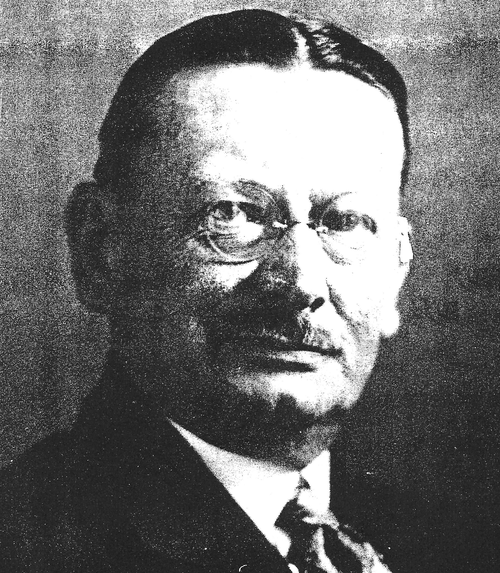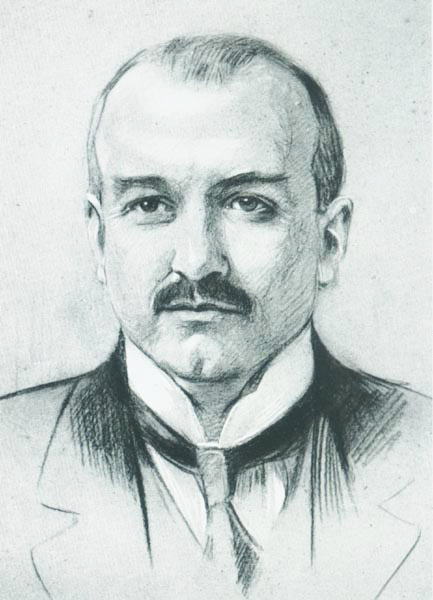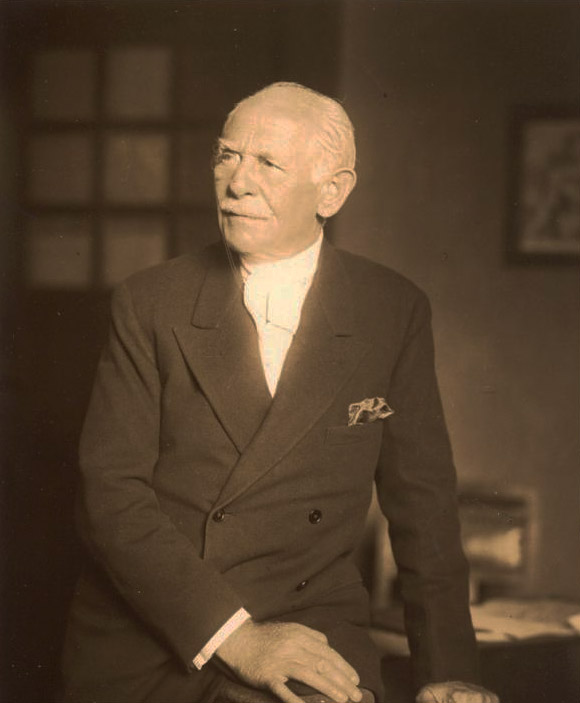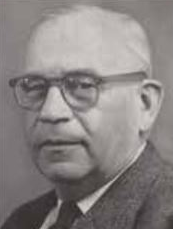Our path into the future
The Deutsche Keramische Gesellschaft (DKG) was founded in 1919 and has existed as an association since 1920. The Technical-Scientific Department (TWA), as DKG's preceding organization, has already been founded in 1913 . Here, you learn more about the more than one hundred year history of our society.
The origin
Technical-Scientific Department (TWA) in the Ceramic Trades Association (VKG) in Germany (1913-1918) Dr. Zimmer (image) brought the idea of founding a technical-scientific association of ceramists in Germany with him from the USA. There, the "American Ceramic Society“ (ACerS) was founded in 1899. In Japan, such an association already existed since 1891. Dr. Uhlitzsch, Managing Director of the Ceramic Trade Association (VKG) in Germany was open to the project and convinced its members to create a "Technical-Scientific Department (TWA)“.
Dr. Zimmer (image) brought the idea of founding a technical-scientific association of ceramists in Germany with him from the USA. There, the "American Ceramic Society“ (ACerS) was founded in 1899. In Japan, such an association already existed since 1891. Dr. Uhlitzsch, Managing Director of the Ceramic Trade Association (VKG) in Germany was open to the project and convinced its members to create a "Technical-Scientific Department (TWA)“.
On June 13, 1913, the inaugural meeting of the "Technical-Scientific Department" of the VKG in Germany took place in the lecture hall of the Technical-Chemical Institute of the Royal Technical University of Berlin. The Chairman of the Ceramic Trades Association, General Director Dr. Roger von Boch-Gahlau (image) opened the meeting with the following words:
"As Chairman of the Ceramic Trades Association in Germany, I have the pleasant duty of greeting you most cordially and welcoming all of you who have appeared here for the opening session of the technical-scientific department.“
69 companies as well as 14 individual members and 27 representatives of science and education joined the TWA already at the foundation. It was chaired by the director of the Königliche Porzellan-Manufaktur Berlin, Dr. Heinecke. From the beginning, scientific lectures formed an important part of the general meetings. The "Reports of the Technical-Scientific Department" (nowAssociation Journal cfi/journal of theDKG) were created as a publication for reporting on the main and side meetings.
The foundation

On September 29, 1919, an extraordinary general meeting was called by the chairman of the Association of Ceramic Trades in Germany (VKG), Geh. Kommerzienrat Dr. Ing. h. c. Rosenthal (image). In the business part, the chairman referred to the reorganization of the VKG and the associated need to reorganize the TWA as well. Dr. Rosenthal stated that the competitiveness of the ceramics industry could only be maintained by a consistent combination of all technical and scientific support possibilities of the circles interested in the industry. Therefore, in a first step, the TWA had to elect a provisional board and a provisional working committee to which the tasks of drafting a new constitution and submitting it to a general meeting to be convened at a later date fell. At this general meeting, the following were elected as provisional board members:
- Prof. Dr. Reisenegger,
- Dr. Heine,
- Dr. Singer,
- Dr. Rosenthal and
- PD Dr. Rieke.
The first General Meeting (1920)
On September 4, 1920, Dr. Heine, representing Prof. Reisenegger, welcomed numerous guests and representatives from the Reich Patent Office, the Reich Coal Commissioner, the Brennkrafttechnische Gesellschaft, the Association of German Engineers, many universities, the press and all members present at the Hotel Bellevue in Dresden. Dr. Heine informed the participants of the meeting that in a meeting held in the morning of the Technical-Scientific Department of the Association of Ceramic Trades in Germany, the dissolution and its transition into an independent German Ceramic Society, with simultaneous takeover of the assets of the predecessor organization, was unanimously decided.
Subsequently, Dr. Uhlitzsch took the floor (excerpts from his speech):
Gentlemen!
At the extraordinary general meeting of the Association of Ceramic Trades in Germany held in Berlin on September 29, 1919, the reorganization of the Technical-Scientific Department was also started as a natural consequence of the change in the association. First of all, a provisional executive committee and a provisional working committee were elected and these bodies were charged with drafting a constitution. In drawing up the statutes, it was to be kept in mind that the organization should continue to work in faithful pursuit of the principles of the Technical-Scientific Department that had been upheld since its foundation in 1913.
These are:
- To promote ceramics in technical, scientific, and artistic relations; to bring together theory and practice in all ceramic matters; and to stimulate the addition, enrichment of all existing ceramic knowledge, both spoken and written, and thus to widen the circle of those interested in ceramics. […]
- The society also has to ensure that the next generation receives a solid professional education by joining all forces. […]
- These goals make it understandable that, according to the unanimous opinion, the work of the new society cannot be limited to the field of fine ceramics, but must be extended to the entire field of ceramics because of the numerous interlocking interests.
- The draft statutes of the TWA were approved at the board meeting of the Association of Ceramic Trades in Germany held in Berlin on January 21, 1920, and it was decided that the new organization would take the name of the Deutsche Keramische Gesellschaft (DKG) with immediate effect. According to the statutes, the entire administration of the society is now in the hands of the board, the working committee and this general meeting.
On September 5, 1920, the first board members of the society were elected and unanimously confirmed at the 1st DKG General Meeting:
1st Chairman: Prof. Dr. Reisenegger, Berlin
2nd Chairman: Director Dr. Heine, Bonn
3rd Chairman: Dr.-Ing. Singer, Selb
- Board and Managing Director: Dr. Uhlitzsch
- Board scientific/literary works: PD Dr. Rieke
- Board: Geh. Kommerzienrat Dr.-Ing. e. h. Rosenthal
Our history (a brief outline since 1920)
In 1920, in addition to the first publication of the "Berichte der DKG" (Reports of the DKG), the first annual conference and the 1st general meeting of the DKG took place at the same time, combining scientific lectures with factory visits. Two years after the organizational separation from the Verband der Keramischen Gewerke (VKG), the office was moved from Bonn to Berlin.
The first focus of work under the first DKG president, Prof. Dr. Reisenegger, head of the Technical-Chemical Institute of the TH Berlin, was the promotion of young ceramists and the expansion of the technical schools.
Under the leadership of the DKG, the first academic ceramics course in Germany was established. The DKG established the first ceramics chair at the TH Berlin-Charlottenburg in cooperation with the responsible ministries. Another success was that the "Technisch-Chemische Versuchsanstalt" at the Staatliche Porzellan-Manufaktur Berlin was recognized as a university institute, with the right to accept diploma and doctoral theses.
Together with Mr. Steger and Mr. Hecht, Prof. Dr. Rieke, who was appointed to this first chair, ensured that ceramics was established at a scientific level. The first graduates of this university institution were equipped with the intellectual foundation that not only enabled significant advances for the German ceramics industry, but also made it a technical and scientific leader on a global scale.
In 1925, the "Scientific Advisory Board of the DKG" was established. Special committees – the forerunners of today's DKG technical and specialist area committees – have since been concerned with individual specialist areas such as raw materials, materials testing and machine technology, etc.
The success of the DKG was reflected in a lively response from industry, science and academia. Already in the mid-twenties of the 20th century, more than 500 people were regularly present at the DKG Annual General Meetings (today DKG Annual Meetings).
The DKG presented its first awards in Heidelberg in 1929. There, for the first time, it awarded the Seger and Böttger plaques to deserving members and ceramists. Under the presidents Mr. Fellinger (1929–1937) and Mr. Willach (1937–1945) also the heavy clay ceramics and other fields of ceramics were integrated into the DKG according to the statutes.
In 1944, the DKG was dissolved by NSDAP resolution and forcibly incorporated into the NS Federation of German Technology.
Whereas the DKG could count more than 1,150 personal members and several hundred legal members before World War II, the society suffered great personnel losses due to the war. The entire Berlin institute was destroyed by bombs. Prof. Dr. Rieke died during the war and with the end of the war the DKG – like all associations – was forcibly dissolved.
A new foundation of the DKG was not possible until March 19, 1949 at the bizonal level in Germany.
 Without the great personal commitment of Dr. Guilleaume (right-hand picture/Managing Partner of Schleifscheibenfabrik Dr. O. Goertz und W. Guilleaume, Bonn), the history of the DKG would have ended after World War 2. Due to his merits in the re-foundation of the DKG, Dr. Guilleaume was elected as the new President of the Association at the first DKG Annual General Meeting of the post-war period. Under Dr. Guilleaume, the DKG was again admitted to the European Confederation of Ceramic Associations (CIC) as early as 1950. Under his presidency, the DKG succeeded in reestablishing or reopening the ceramic research institutes in Aachen, Clausthal and the Institute for Silicate Research in Würzburg as compensation for the loss of the training centers in Berlin, Breslau and Bunzlau.
Without the great personal commitment of Dr. Guilleaume (right-hand picture/Managing Partner of Schleifscheibenfabrik Dr. O. Goertz und W. Guilleaume, Bonn), the history of the DKG would have ended after World War 2. Due to his merits in the re-foundation of the DKG, Dr. Guilleaume was elected as the new President of the Association at the first DKG Annual General Meeting of the post-war period. Under Dr. Guilleaume, the DKG was again admitted to the European Confederation of Ceramic Associations (CIC) as early as 1950. Under his presidency, the DKG succeeded in reestablishing or reopening the ceramic research institutes in Aachen, Clausthal and the Institute for Silicate Research in Würzburg as compensation for the loss of the training centers in Berlin, Breslau and Bunzlau.
In the 1950s, the office of the association was moved under Mr. Knauf first to Bonn and then to Bad Honnef (1959). The editorial office and coordination of the scientific work was located in Würzburg under Mr. Dietzel.
In 1957 Dr. Dr.-Ing. e. h. G. Cremer (picture) took over the chairmanship of the DKG for twelve years (1957–1969). His merits consisted in particular in the consistent continuation of the promotion of young talents, the support of the ceramic arts and crafts and in the reintegration of German ceramics into international events. Under Dr. Cremer, the DKG succeeded in organizing the VI Congress of the CIC in Wiesbaden and thus ultimately restored the presence of German ceramics internationally after World War II.
After the revival of academic research and teaching, the DKG devoted more attention to engineering and technical schools from 1961 onward. The reason for this was the structural changes in industry – away from master craftsmen to engineering companies. Together with its partners, the DKG had to ensure that scientific and technical developments in ceramics (including the establishment of Technical Ceramics) were also reflected in training. At the end of the 1960s, therefore, the training program for "ceramics technicians" was also launched.
Around 1965, the DKG again reached the membership strength of the pre-war period around 1939. More than 500 participants regularly came to the DKG annual meetings, which were now also held in German-speaking countries, for example in Basel, Salzburg and Luxembourg.
In the mid-1970s, after economic challenges within the DKG, President Mr. Lehmann and Managing Director Mr. Hartinger succeeded in consolidating the Society financially again by 1981 through various measures, such as the editorial outsourcing of the Association's journal "Berichte der DKG" to Bauverlag.
In 1984, Dr. Blumenberg took over the management (1984–2011) from Mr Rechenberger (1981–1984) and moved the office from Bad Honnef to Cologne. Under Dr. Blumenberg the DKG succeeded in integrating successfully the professional activities from industry, science and education from the areas of Central Germany (colloquially: new federal states), which were among the most active, ceramic regions before World War II.
At the same time, Prof. Hausner (President 1987–1991) contributed to the further internationalization of the DKG. In 1989, the DKG, as the largest ceramic organization in Europe, became an important founding member of the European Ceramic Society (ECerS). The Society also became a founding member of the International Ceramic Federation (ICF).
Prof. Hausner was re-elected as the second ECerS President (1989–1991) and third ICF President (1993-1995). Building on this, the Society continued to develop under the presidencies of Mr. Schmidt (1991–1995), Dr. Walter (1995–1999), Prof. Dr. Schulle (1999–2003), Prof. Dr. Heinrich (2003–2007) and Prof. Dr. Telle (2007–2011).
In 2011, Dr. Blumenberg retired and Dr. Nicklas took over the management of DKG. In the same period, new impulses from the ceramic industry, science and teaching (keyword: Industry 4.0/... the intelligent networking of machines and processes) gave the society new tasks and the opportunity for further development thrusts, which were successfully accepted under the presidencies of Mr. Griebe (2011–2015), Mr. Heym (2015–2019) and Prof. Dr. Michaelis (since 2019) as well as many other members not mentioned here.
Today, DKG is the most member-strong, ceramic society in Europe and has resumed its traditional place in the national and international (ceramic) community. For more than 100 years, the society has now been the forum for all technical and scientific questions concerning ceramics. The DKG members thus cultivate and maintain a unique network between users, manufacturing industry, supplier industries, research, science and teaching. The DKG is thus once again a sought-after contact for ceramics as a material.
As of 2019 – the second century of its existence – DKG is still committed to its 1919 motto:
CERAMICS - Material of mankind!
Source: H. Reh: Die DKG und die deutsche Keramik-Geschichte. In: cfi/Berichte der DKG 71 (1994) No. 7, 351-359. Ergänzungen: DKG (2011 - 2022)

